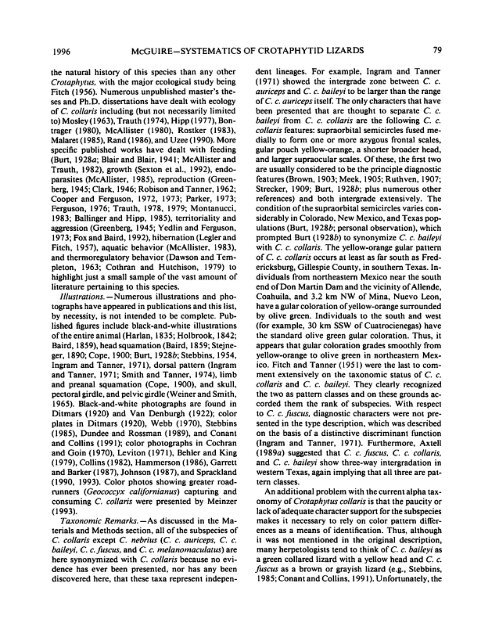Download Full Document - Mountain Boomer Music!
Download Full Document - Mountain Boomer Music!
Download Full Document - Mountain Boomer Music!
You also want an ePaper? Increase the reach of your titles
YUMPU automatically turns print PDFs into web optimized ePapers that Google loves.
1996 McGUIRE-SYSTEMATICS OF CROTAPHYTID LIZARDS 79<br />
the natural history of this species than any other<br />
Crotaphytus, with the major ecological study being<br />
Fitch (1956). Numerous unpublished master's the-<br />
ses and Ph.D. dissertations have dealt with ecology<br />
of C. collaris including (but not necessarily limited<br />
to) Mosley (1 963), Trauth (1974), Hipp (1 977). Bon-<br />
trager (1980), McAllister (1980), Rostker (1983),<br />
Malaret (1 985), Rand ( 1986), and Uzee (1 990). More<br />
specific published works have dealt with feeding<br />
(Burt, 1928a; Blair and Blair, 194 1 ; McAllister and<br />
Trauth, 1982), growth (Sexton et al., 1992), endo-<br />
parasites (McAllister, 1985), reproduction (Green-<br />
berg, 1945; Clark, 1946; Robison and Tanner, 1962;<br />
Cooper and Ferguson, 1972, 1973; Parker, 1973;<br />
Ferguson, 1976; Trauth, 1978, 1979; Montanucci,<br />
1983; Ballinger and Hipp, 1985), territoriality and<br />
aggression (Greenberg, 1945; Yedlin and Ferguson.<br />
1973; Fox and Baird, 1992), hibernation (Legler and<br />
Fitch, 1957), aquatic behavior (McAllister, 1983),<br />
and thermoregulatory behavior (Dawson and Tem-<br />
pleton, 1963; Cothran and Hutchison, 1979) to<br />
highlight just a small sample of the vast amount of<br />
literature pertaining to this species.<br />
Illustrations. -Numerous illustrations and pho-<br />
tographs have appeared in publications and this list,<br />
by necessity, is not intended to be complete. Pub-<br />
lished figures include black-and-white illustrations<br />
of the entire animal (Harlan, 1835; Holbrook, 1842;<br />
Baird, 1859). head squamation (Baird, 1859; Stejne-<br />
ger, 1890; Cope, 1900; Bun, 19286; Stebbins, 1954,<br />
Ingram and Tanner, 197 l), dorsal pattern (Ingram<br />
and Tanner, 197 1; Smith and Tanner, 1974), limb<br />
and preanal squamation (Cope. 1900). and skull,<br />
pectoral girdle, and pelvic girdle (Weiner and Smith,<br />
1965). Black-and-white photographs are found in<br />
Ditmars (1 920) and Van Denburgh (1 922); color<br />
plates in Ditmars (1920), Webb (1970), Stebbins<br />
(1 985), Dundee and Rossman (1 989), and Conant<br />
and Collins (1 991); color photographs in Cochran<br />
and Goin (1970), Leviton (197 I), Behler and King<br />
(1 979), Collins (1 982), Hammerson (1 986), Garrett<br />
and Barker (1 987), Johnson (1 987), and Sprackland<br />
(1990, 1993). Color photos showing greater road-<br />
runners (Geococcyx californianus) capturing and<br />
consuming C. collaris were presented by Meinzer<br />
(1 993).<br />
Taxonomic Remarks. -As discussed in the Ma-<br />
terials and Methods section, all of the subspecies of<br />
C. collaris except C. nebrius (C. c. auriceps, C. c.<br />
baileyi, C. c. jiuscus, and C. c. melanomaculatus) are<br />
here synonymized with C. collaris because no evi-<br />
dence has ever been presented, nor has any been<br />
discovered here, that these taxa represent indepen-<br />
dent lineages. For example, Ingram and Tanner<br />
(1971) showed the intergrade zone between C. c.<br />
auriceps and C. c. baileyi to be larger than the range<br />
of C. c. attriceps itself. The only characters that have<br />
been presented that are thought to separate C. c.<br />
baileyi from C. c. collaris are the following C. c.<br />
collaris features: supraorbital semicircles fused medially<br />
to form one or more azygous frontal scales,<br />
gular pouch yellow-orange, a shorter broader head,<br />
and larger supraocular scales. Of these, the first two<br />
are usually considered to be the principle diagnostic<br />
features (Brown, 1903; Meek, 1905; Ruthven, 1907;<br />
Strecker, 1909; Burt, 19286; plus numerous other<br />
references) and both intergrade extensively. The<br />
condition of the supraorbital semicircles varies considerably<br />
in Colorado, New Mexico, and Texas populations<br />
(Burt, 1928b; personal observation), which<br />
prompted Burt (19286) to synonymize C. c. baileyi<br />
with C. c. collaris. The yellow-orange gular pattern<br />
of C. c. collaris occurs at least as far south as Fredericksburg,<br />
Gillespie County, in southern Texas. Individuals<br />
from northeastern Mexico near the south<br />
end of Don Martin Dam and the vicinity ofAllende,<br />
Coahuila, and 3.2 km NW of Mina, Nuevo Leon,<br />
have a gular coloration of yellow-orange surrounded<br />
by olive green. Individuals to the south and west<br />
(for example, 30 km SSW of Cuatrocienegas) have<br />
the standard olive green gular coloration. Thus, it<br />
appears that gular coloration grades smoothly from<br />
yellow-orange to olive green in northeastern Mexico.<br />
Fitch and Tanner (1 95 1 ) were the last to comment<br />
extensively on the taxonomic status of C. c.<br />
collaris and C. c. baileyi. They clearly recognized<br />
the two as pattern classes and on these grounds accorded<br />
them the rank of subspecies. With respect<br />
to C. c. fuscus, diagnostic characters were not presented<br />
in the type description, which was described<br />
on the basis of a distinctive discriminant function<br />
(Ingram and Tanner, 1971). Furthermore, Axtell<br />
(1989~) suggested that C. c. jicscus, C. c. collaris,<br />
and C. c. baileyi show three-way intergradation in<br />
western Texas, again implying that all three are pattern<br />
classes.<br />
An additional problem with the current alpha taxonomy<br />
of Crotaphytus collaris is that the paucity or<br />
lack of adequate character support for the subspecies<br />
makes it necessary to rely on color pattern diKerences<br />
as a means of identification. Thus, although<br />
it was not mentioned in the original description,<br />
many herpetologists tend to think of C. c. baileyi as<br />
a green collared lizard with a yellow head and C. c.<br />
fuscus as a brown or grayish lizard (e.g., Stebbins,<br />
1985; Conant and Collins, 199 I). Unfortunately, the


